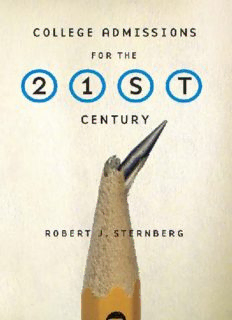
College Admissions for the 21st Century PDF
Preview College Admissions for the 21st Century
COLLEGE ADMISSIONS FOR THE 21ST CENTURY COLLEGE ADMISSIONS FOR THE 21ST CENTURY RobertJ.Sternberg HARVARDUNIVERSITYPRESS Cambridge,Massachusetts&London,England 2010 ToHenryChauncey,Jr. Copyright©2010bythePresidentandFellowsofHarvardCollege Allrightsreserved PrintedintheUnitedStatesofAmerica LibraryofCongressCataloging-in-PublicationData Sternberg,RobertJ. Collegeadmissionsforthe21stcentury/RobertJ.Sternberg. p.cm. Includesbibliographicalreferencesandindex. ISBN978-0-674-04823-2(cloth:alk.paper) 1.Universitiesandcolleges—UnitedStates—Admission. 2.Education,Higher— Standards—UnitedStates. 3.Educationalequalization—UnitedStates. I.Title. LB2351.2.S742010 378.1′61—dc22 2010011512 CONTENTS Preface vii 1.CollegeAdmissionsandTesting 1 2.HowWeGotHere: TheTraditionalCollegeApplication 35 3.AlternativeAdmissionsPractices 58 4.ANewWayofLookingatIntelligenceandSuccess 71 5.AssessingHiddenTalents 109 6.EncouragingCreativity, PracticalIntelligence,andWisdom 134 7.ImplicationsforStudents,Colleges,andSociety 172 Appendix:KaleidoscopeQuestions fortheClassesof2011–2014 181 Notes 189 Index 201 PREFACE I entered into the admissions business as a sophomore in college. I was interested in how my college,Yale,couldimproveitsadmissionsprocedures.Ihadthe audacity to write to Henry (Sam) Chauncey, Jr., dean of under- graduateadmissionsandfinancialaidpolicy,andsonofthepres- ident of the Educational Testing Service, asking him whether he would be interested in creating a job for me in the Yale under- graduate admissions office. This brazen approach had worked formebefore,havingyieldedsummerjobsformeattwocompa- niesthatcreatedpsychologicaltests,ThePsychologicalCorpora- tion(theninNewYorkCity)andtheEducationalTestingService (in Princeton, New Jersey). I had the first of these jobs during twohigh-schoolsummers,andthesecondwhenIstartedcollege. Chauncey replied and scheduled an interview. He must have been at least somewhat impressed, because he hired me. I am gladhedid,becauseIlearnedalotandmoreoverbecausetothis dayheremainsalifelongfriend. FortwoandahalfyearsIworkedpart-timeinadmissionsand then, after graduating early, I became a special assistant to the dean of undergraduate admissions, who at the time was a man named John Muyskens. I spent a semester doing what admis- sions officers do, as well as researching undergraduate admis- sions.Thosewereheadytimesduringtheearly1970s,whenwe viii PREFACE all believed that we could make the world a better place if only weadmittedthe“right”studentstoYale. I decided that, in order to pursue my interests properly, I would need a PhD, so after that one semester I headed to Stan- ford as a PhD student in psychology. There I would begin what hasbecomealifelongprogramofresearchintothenatureofhu- man abilities, their antecedents, and their consequences. One of mymentors,LeeCronbach,toldmethatthefieldofhumanintel- ligencewasprettymuchdead.ButIhavedonewhatIcantore- viveitovermorethanthirtyyearsofteachingandresearch,dur- ingwhichmyinterestinadmissionshasneverwavered. Three years after entering Stanford, I received my PhD and headed back to Yale as an assistant professor. I was determined to change the way people thought about abilities, and the way such abilities were tested and developed. I suppose that, in the ideal world, I would be writing in this preface about my enor- mous successes. I’ve had some: along the way I have picked up numerous awards and eleven honorary doctorates. But I have hadlittleornosuccess inchangingthewaythisnation tests for ordevelopshumanabilities. The traditional, narrow approach to admissions testing re- minds me of an experience I had last summer, while traveling with my wife. She and I sat in a restaurant with a spectacular viewofanenormouswaterwheelthatwasspinningandchurning water as it had been for scores of years. The wheel looked per- haps a bit worse for wear, but it continued to do, after all the years,thejobitwasconstructedtodo.Itwasofferedbythetown asahistoricallandmark—onethattouristslikeuscouldenjoy. Thestandardizedtestsweusetodayareroughlyasoldintheir conceptionasthatwaterwheelisinitsexecution.Butthesetests arenottreatedmerelyasitemsofhistoricalinterest;insteadthey play a central part in determining which students will make it intowhichcolleges.Imaginewhattheworldwouldbeliketoday if medical, telecommunications, computing, or other technolo- gies were stuck at the beginning of the twentieth century. Many PREFACE ix diseasesthatarenowcurableoratleasttreatablewouldkillpeo- plewhonowcanstayalive.Peoplewouldbewritingalltheircor- respondence with a fountain pen and ink, or with clunky type- writers, instead of with a computer. Overseas telephone calls would still be an expensive novelty. Today’s standardized tests, metaphoricallyspeaking,arethosehistoricalnovelties. That said, the message of this book is not that the standard- izedtestsweusetodayarehorribleandevil,andthattheworld would be a better place if they were to disappear overnight. On thecontrary,suchtests,likeeveryothermeasureusedincollege admissions,havebothstrengthsandweaknesses.Formanyindi- viduals and groups, they are reasonable although not excellent predictors of academic success in college. They tell something aboutastudent’sacademicpotential.AstudentwithSATscores inthelow300sislesslikely,onaverage,tosucceedacademically inahighlyselectivecollegethanastudentwithscoresinthehigh 600s. Atthesametime,scorescanberaisedorloweredbymanyex- tenuating circumstances that the scores, by their very nature, cannot take into account—differences in education, first lan- guage, home environment, conditions of testing, and so forth. My argument is not that tests are intrinsically bad, but rather that the information they give is incomplete—they are not enough.Wecandobetterbydevisingnewassessmentsthatsup- plement the old ones and that more comprehensively reflect the psychologyoftoday,notjustofyesterday. Everytimeonewritesabook,onehopestochangetheworld. If the past is the best predictor of the future, I will not succeed withthisbook.Butthen,ifthefuturewerenodifferentfromthe past,wewouldstillbetravelingbyhorseandbuggy.Sothisbook represents my hope that it is possible for our society to change course and recognize that our traditional way of doing things with regard to admissions, instruction, and assessment is less than optimal and has been for quite a long time. We need to move beyond our horse and buggy mentality in educational in-
Description: